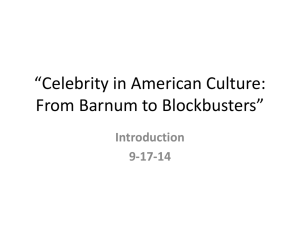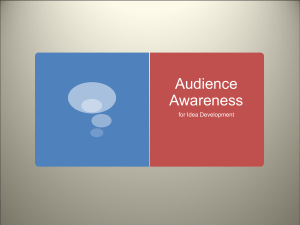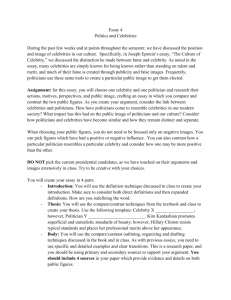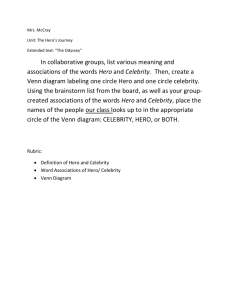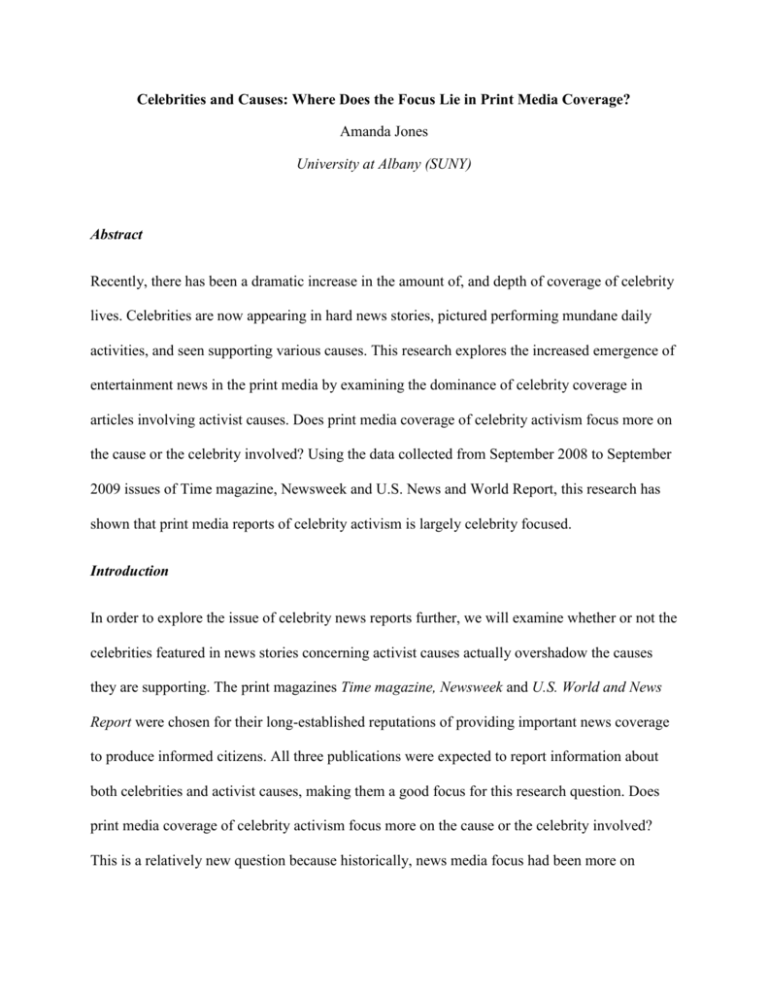
Celebrities and Causes: Where Does the Focus Lie in Print Media Coverage?
Amanda Jones
University at Albany (SUNY)
Abstract
Recently, there has been a dramatic increase in the amount of, and depth of coverage of celebrity
lives. Celebrities are now appearing in hard news stories, pictured performing mundane daily
activities, and seen supporting various causes. This research explores the increased emergence of
entertainment news in the print media by examining the dominance of celebrity coverage in
articles involving activist causes. Does print media coverage of celebrity activism focus more on
the cause or the celebrity involved? Using the data collected from September 2008 to September
2009 issues of Time magazine, Newsweek and U.S. News and World Report, this research has
shown that print media reports of celebrity activism is largely celebrity focused.
Introduction
In order to explore the issue of celebrity news reports further, we will examine whether or not the
celebrities featured in news stories concerning activist causes actually overshadow the causes
they are supporting. The print magazines Time magazine, Newsweek and U.S. World and News
Report were chosen for their long-established reputations of providing important news coverage
to produce informed citizens. All three publications were expected to report information about
both celebrities and activist causes, making them a good focus for this research question. Does
print media coverage of celebrity activism focus more on the cause or the celebrity involved?
This is a relatively new question because historically, news media focus had been more on
events, crime and government happenings. The recent introduction of the internet now allows
users access to more information than ever before on a constant basis. For this and other reasons,
media outlets have begun to report on a wider variety of information, including celebrities. Many
have also allowed first hand access into the personal lives of celebrities and everyday citizens by
filming reality television shows. Celebrity coverage has been gaining rapidly in popularity and
the question of what gains more attention when celebrities are involved with activist causes has
yet to be addressed.
Literature Review
The advancement of and growing access to digital media has been the focus of many
recent communication scholars. With so many different channels of media to choose from, the
concept of what is considered news has expanded. A lot of attention has been paid to the
increasing celebrity exposure in the mass media. Information that was once exclusive to tabloid
coverage is being reported on the evening news; reality television shows dominate the airwaves;
and advertisements featuring celebrities are nearly inescapable. The majority of literature on this
topic focuses on finding somewhere to place blame for the decrease in traditional, hard news
coverage in favor of more entertainment and celebrity based news. According to Bennett (2007),
hard news by journalistic standards includes things an informed person in society should know
such as electoral candidates, life-changing policies, emerging social problems, environmental
issues and historic events. Soft news, by contrast, is dramatic, sensational, emotional and
immediate. (Bennett, 2007). This shift in media coverage has led many to critically evaluate the
mass media and its place in American society. Social problems seemingly linked to increased
celebrity exposure are often determined to be produced by the mass media. However, some
scholars refute the charge that the media is to blame, instead shifting the focus back onto
American society and family values. While the one clear villain in the situation is yet to be
determined, the majority of research on the celebrity obsession in American culture and mass
media remains focused on its negative causes and/or effects. But the argument is cyclical,
unending and disregards what news stories featuring celebrities are actually about.
News, in the traditional sense of producing informed citizens, has not necessarily
vanished, but it is harder to uncover than ever before due to the blending of hard and soft news
and the vast amounts of information now available through a wide variety of media.
Additionally, the definition of news has changed over time. Bennett references Doris Graber to
allege that current news contains information that is timely, sensational and familiar (Bennett,
2007). By focusing on the aforementioned aspects when reporting news, a key component is
overlooked: providing information. “There are no laws that command that the news must educate
the public” (Bennet, p. ix, 2007). With no mandate to focus the news on educating viewers, but
many other requirements in terms of ratings and revenue, the mass media has been shifting
toward a trend of sensationalism. The quality of news provided by the mass media has been
brought into question recently. “Filled with growing volumes of political spin, sensation, and
insider buzz, the daily news sometimes provides, but increasingly does not offer, citizens a solid
basis for critical thinking or effective action” (Bennett, p.xvi, 2007). News stories often do not
provide enough information or portray larger societal implications in ways that informs and
educates viewers. This lack of informative reporting is a result of the way in which the mass
media cover stories. Bennett (2007) discusses several basic news biases including,
“…fragmentation (the lack of context surrounding emergent issues and problems), the
personalization of stories around the most emotional aspects (rather than emphasizing
broader social conditions and issues), the dramatization of often trivial aspects of events
(and the search for sensational stories rather than representative ones), and a
preoccupation with questions of authority and social order at the expense of analyzing
underlying social problems and issues” (Bennett, p.29, 2007).
For example, coverage of mass tragedies tend to be covered more heavily in the mass media than
local crime stories that, in reality, are more relevant to viewer’s lives. When smaller scale local
crime stories are reported on, it is often done in a way that focuses on the personalities of the
victims involved, rather than the larger community implications, like a rising crime rate. News
stories such as these seek to entertain, rather than educate viewers.
Fragmented, personalized, dramatic, sensational reporting lends itself well to celebrity
news. This is evidenced by the fact that a growing number of television shows report tabloid
style celebrity information in this way. Celebrity gossip, celebrity endorsements and the
encouragement of the general public to become celebrities through reality television shows
provide a good topic for entertaining, soft news pieces. These stories are timely, sensational and
familiar because celebrity news is available on a regular basis. There are little restrictions placed
on the depth of coverage allowed of celebrity personalities’ lives. Celebrities are also used to
endorse nearly every product on the market, and the rise in reality television programming brings
the stars into viewers’ homes on a weekly basis. According to West & Orman (2003), the
‘democratization’ of fame has encouraged fame across different contexts, including but not
limited to politics. “No longer was fame restricted to legacies or individuals holding privileged
positions, such as kings and popes, but it was possible for ordinary people to be elevated to
social and political prominence” (West & Orman, p.8, 2003). This availability of celebrity status
has caught the attention of citizens across the country. A recent topic of great personal interest to
the general American public has become the concept of ‘fame’. According to Sean Redmond,
“…fame culture offers ‘ordinary’ and ‘extraordinary’ people the chance of a heightened level of
intimacy, an intimacy that potentially, perhaps inevitably, destabilizes the borders and
boundaries of identity, and which energizes or electrifies one’s experience with the world”
(Holmes & Redmond, p.27, 2006). In fact, mass media consumers are taking more and more of
an interest in celebrity personalities, reality television stars, bloggers and YouTube video stars.
“Ordinary/extraordinary people do this willingly because to be offscreen, offline, or out of print
is, as Nick Couldry (2003) argues, no longer satisfactory, or empowering, in a world where the
acquisition of fame is the affirmation of the self” (Holmes & Redmond, p.29, 2006). American
citizens willingly cross the line from private citizens into celebrity status every day.
“As Barbara Goldsmith has observed, “Today we are faced with a vast confusing jumble
of celebrities: the talented and the untalented, heroes and villains, people of
accomplishment and those who have accomplished nothing at all”. We are not very
discerning as a society when it comes to making qualifications for those to be celebrated”
(West & Orman, p.13, 2003).
The means by which to become a celebrity are also continually expanding as technology
expands, as is the American public acceptance of just about anyone as a celebrity figure.
Regardless of how one becomes famous, any appearance in the media results in widespread
recognition and digital imprint in history that is impossible to erase. Reports of soft news far
outweighing the amount of hard news in today’s mass media landscape can be traced, in part,
back to the technological changes seen in modern times.
According to Bennett (2007), some of factors affecting the increase of soft news include
the economics of the news business, journalists’ dependence on sources who control information,
routine news-gathering practices, professional norms and a need to fill the news hole that has
been created by 24/7 news coverage. Celebrity focused, soft news tends to be quick and easy to
report about. Additionally, such stories have proven to be popular among audiences and are easy
to dramatize. Celebrity stories may also serve the uses and gratifications of many audience
members. Bennett (2007) suggests that in addition to learning, many viewers use news to satisfy
their needs for curiosity and surveillance, entertainment and escape, and social and psychological
adjustment. “With the advent of the Web and the Internet, increasing numbers of citizens turn to
alternative information channels that deliver politically packaged information in a format better
integrated with personal interests and various citizen-action options” (Bennett, p.82, 2007). This
statement is true of all news information, not just politics. There are websites, magazines,
newspapers, television stations, etc. to suit every different need and consumers have the choice
to visit only the ones that interest them. Therefore, the shift seen in news coverage from
informative to entertaining cannot be blamed solely on the media. The vast amount of resources
available to the American audience ensures that everyone’s needs can, in fact, be met. In
actuality, according to Sternheimer,
“Media act as a refracted social mirror, providing us with insights about major social
issues such as race, gender, class, and the power and patterns of inequality. The media are
an intricate element of our culture, woven into the fabric of social life. We can learn a lot
about American society from media culture if we stop insisting on using only causeeffect logic” (Sternheimer, p.17, 2010).
Rather than see one component of news consumption as affecting the other linearly when it
comes to news quality, it is important to see the two way flow that affects the amount of hard
versus soft news. It is equally true that the media frequently report about soft news topics like
celebrities, as well as that the American public show great interest in celebrity news stories. The
question then becomes not why soft news and celebrity coverage have become the norm, but
why the reports almost always have a negative frame.
Despite all the yearning by the general public to become famous, celebrities are often
seen as fair game for public fodder and criticism. The news stories about celebrities that most
often permeate the media airwaves are about stars’ mishaps and blunders. Together with media,
they are often blamed for social problems. A common complaint is that celebrities are bad role
models and mass media idolizes them anyway. Such practices are thought to be teaching younger
generations to fall into drugs like Britney Spears, become over-sexualized like Miley Cyrus, or
anorexic looking like Nicole Ritchie.
“As exemplified in the following quote by Bob Franklin, this is conceived as the
diversion of media audiences from ‘hard’ news and issues of public interest to ‘soft’
tabloid focuses such as human interest, sport, scandal and celebrity: Entertainment has
superseded the provision of information; human interest has supplanted the public
interest; measured judgment has succumbed to sensationalism; the trivial has triumphed
over the weighty; the intimate relations of celebrities from soap operas, the world of sport
or the royal family are judge more ‘newsworthy’ than the reporting of significant issues
and events of international consequence (1997: 4)” (Holmes & Redmond, pp.344-345,
2006).
While this criticism is founded in reality, the overabundance of human interest stories is not so
much a problem as the lack of positive aspects to these stories. Weight loss and gain are common
topics in celebrity news reports, as are drunken shenanigans and infidelity. Celebrities are largely
ignored for receiving accolades that celebrity their professional achievements or humanitarian
work that they may devote themselves to extensively. The mass media are continuously
criticized for providing soft news to its audience, however many shifts in the social landscape
(not the least of which being audience approval) have given way to the shift we see in the news
today. “Celebrities become products and are endowed with expertise outside of their celebrated
areas” (West & Orman, p.118, 2003). The celebrity culture today expects that stars be
spokespersons for all kinds of issues, as well as bear the responsibility for issues that are
problematic. This power is not derived from within these stars, but rather from the audience’s
interest in them. Celebrities are expected by many to be shining examples of model citizens, yet
their good deeds like activism are overlooked in favor of scandalous, dramatic, negative reports
about them. As of late, the American public has shown a clear, somewhat obsessive interest in
celebrity news. In particular, the focus has been placed on uncovering damaging celebrity news.
The main focus of celebrity based news stories seem to be on gathering evidence that will
damage the star’s status as an iconic figure. “Journalist Caspar Llewellyn-Smith makes this point
when he states that the guiding principle of celebrity gossip magazines is to show famous figures
‘off-guard, unkempt, unready and unsanitized’ (Llewellyn-Smith, 2002: 120, cited in Holmes,
2005: 23)” (Holmes & Redmond, p.184, 2006). The mass media are, in effect, making a
concerted effort to provide unflattering coverage of celebrity personalities. It is these kinds of
news stories that are increasingly present in our every day mass media outlets. Such stories
provide the drama and sensationalism that media consumers are looking for. Celebrity personas
have been used at the need and disposal of American consumers for decades, as verified by
source models discussed by McCracken (1989). “According to the model, the persuasiveness of
the celebrity has everything to do with the celebrity and nothing to do with the product”
(McCracken, p.311, 1989).In the same way that marketers have linked positive views of
celebrity personalities with products, negative news stories are currently painting a picture of an
immoral celebrity landscape that may not be entirely true.
There are many cases in which celebrities promote social change or activism in addition
to, or in conjunction with, their famous lives. “For example, Brown used her notoriety gained
during the O.J. Simpson murder trial to become a national spokesperson on domestic violence”
(West & Orman, p.4, 2003). There are many different types of celebrities that can be accessed
through many different channels of media in today’s world. West & Orman (2003) cite five
categories of celebrities including, political newsworthies, legacies, elected officials, lobbyists
and spokespersons, and event celebrities. With so many famous personalities to choose from,
there are sure to be some stars involved in causes, yet we rarely hear about it. “These
newspapers, then, are clearly part of an extortion of celebrity across contemporary culture, and
are often seen as having contributed to a shift towards personalization of the media as a whole”
(Holmes & Redmond, p.344, 2006). Focus is rarely placed on stars’ professional
accomplishments (which is the very essence of their fame in the first place), but rather on their
private lives and individual flaws. The famous personalities in American celebrity culture today
are at the mercy of what advertisers wish to promote or denounce, what journalists consider
newsworthy, and what consumers want to hear about; all of which has been overwhelmingly
negative recently. But the usefulness of stars’ fame in promoting various causes is being
overlooked. “Their centrality in the mobilization of interests and recruitment of candidates gives
them special power. They are able to position themselves in ways that enhance their overall
influence” (West & Orman, p.6, 2003). This is true of any cause, albeit political or not.
Celebrities are capable of giving much more prominence to causes they involve themselves with,
but attention must first be paid to their positive, humanitarian efforts. Once again, this can be
brought back to Bennett’s (2007) idea that the mass media’s focuses on the fragmented,
personalized, dramatic, sensational style of news stories. Unfortunately, there is some question as
to whether this type of reporting portrays celebrities negatively and perhaps in turn, overshadows
important, newsworthy activist causes.
Rather than focus on the effects of celebrity coverage in the mass media on news quality,
the question needs to be addressed as to the focus of such celebrity coverage in the mass media.
Celebrities are not always drunk and partying. Nor does reporting on stories of stars buying
coffee in the morning warrant any type of award for extremely informative, high quality news
coverage. These are simple, logical conclusions. Yet, much of the focus of celebrity news
appears to be framed negatively to create drama and stir the public’s interest. In reality, many
celebrity personalities are involved in charities and other causes. Some public personas actually
do use their fame to accomplish good deeds. The American public has shown an enduring
interest in celebrity life and fame in general. It’s time to examine how these celebrity news
pieces are covered in relation to those involved in activist causes. Will media coverage of the
celebrities involved in causes continue to report mostly negative, dramatic, personalized
coverage of the stars, or devote more attention to the cause they are involved in? In order to
develop an informative but manageable research question, in this study I will ask: Does print
media coverage of celebrity activism focus more on the cause or the celebrity involved?
Summary
The literature available regarding celebrities and their involvement in activist causes is
limited to non-existent. The majority of today’s literature on related topics examines the structure
of the American mass media today with relation to celebrity gossip news stories and social
problems. The understanding of how the news has changed is explored in depth by Bennett
(2007) who makes the distinction between hard news and soft and references how the mass
media today blends the two together. The structure of the news is also called into question by
Bennett (2007), who cites the fragmented, personalized, dramatic, sensationalized style of
reporting that is often seen in the mass media. An examination of the structure of this type of
reporting helps one to see how celebrities have gained so much attention in the media as of late.
The pressure journalists are under to produce ratings and continually turn out stories with little
time to gather information is indicative of the turn toward short, dramatic pieces about the
famous.
The invasion of celebrity gossip into traditionally hard news stories is recognized by
West & Orman (2003) and Holmes & Redmond (2006), among others. A consideration of
McCracken’s (1989) research on celebrity politics indicates a long withstanding, wide reaching
involvement of celebrity personas across many aspects of American culture. The current
obsession with ‘fame culture’ is more closely examined by Holmes & Redmond (2006), who cite
technological advances and a blurring of who can become famous and how as part of the reason
Americans follow celebrities so closely. Yet, West & Orman (2003) expand the notion of
celebrity to include many broad categories of stardom, of whom many tend to make positive
contributions to society. These contributions to various causes however, are continuously
overlooked by today’s media in favor of more sensational, negatively framed news stories. Given
the contribution of these scholars, it is easy to see how the structure of news today, technological
advances and a desire to achieve celebrity status, coupled with a jealousy of those who already
have, create the perfect conditions for the negative celebrity news coverage that is so prominent
in American mass media today.
Method
Every magazine published by Time magazine, Newsweek and U.S. News and World Report
between September 2008 and September 2009 was used in this study. Each article containing a
celebrity and/or an activist cause was coded for prominence, headline, visuals, space on the page
and public involvement. The results of each article were tallied and compared to determine the
overall findings on the stories’ focus on celebrities versus causes.
Coding
The coding of this research was based on several categories to determine the amount of
information dedicated to celebrities and to activist causes. For the purposes of this study,
‘celebrity’ was defined as an individual well-known to the general public for accomplishments in
television, film, athletics or social activities. The term ‘cause’ was defined as an issue one
becomes involved with for the greater good of a population, not solely for personal or monetary
gain. The prominence of the story was assessed first by whether or not it appeared on the front
cover of the magazine, receiving a mark of yes or no. It was then determined if the story was one
or more pages, or if it was less than a page. The headline of the story was examined for mention
of the celebrity, the cause or both. Visuals of the piece were assessed to determine if the
celebrity, the cause, or both were featured. The space on the page was rated for both dedication
to the celebrity and dedication to the cause separately on a scale from one to five (one being the
least amount of space and five being the most space).The opportunity for public involvement
was also determined to be either advertising for the celebrity, how to help with the cause
mentioned or both.
Results
The results of this study show a clear tendency of journalists (within the print media context
addressed) to focus stories about celebrity causes on the life, or personality of the celebrity,
rather than issues related to the activist cause. For the purposes of this study, ‘celebrity’ was
defined as an individual well known to the general public for accomplishments in television,
film, athletics or social activities. ‘Causes’ were defined as issues one becomes involved with for
the greater good of a population, not solely for personal or monetary gain. The volume of articles
related to both terms were limited to begin with, demonstrating a lack of reporting concerning
this positive aspect of celebrity lives. Six articles from Time magazine, eleven from Newsweek
and zero from U.S. News and World Report were found containing information about both
celebrities and causes.
The articles that were found to contain both criteria often presented the cause as one of
the central features of the article. This was done by means of mentioning the cause within the
headline of the article. However, those articles that did contain information about both a celebrity
and related cause, were three times more likely to have a visual of the celebrity rather than one
representing the cause, or both the celebrity and the cause. For example, an article that was
published in Newsweek titled, “The Legacy of a Family of Strong Women” (Nixon, 2008) cites
Cynthia Nixon in the subtext as an actor and activist, paired with a picture of the beautiful
actress. But the article goes on to talk largely about Nixon’s personal life and gives no means
through which to get involved with the causes Nixon is involved in. An overwhelming majority
of the articles determined to meet both criterion were allotted one page or more within the
magazine, indicating an elevated prominence of the news story. However, the space on the page
devoted to the celebrity versus the cause won out by a margin of 25%. A great example of such
an article and its fragmented, sensationalized style of reporting appears in Time magazine. Titled,
“The Moment 10/28/08: Chicago” (Chua-Eoan, 2008), this story briefs readers on the tragedy of
the murder of Jennifer Hudson’s family, asking why it takes an Academy Award for such a
tragedy to make headlines. However, amidst the criticism of sensationalized reporting, the
majority of space within the article is dedicated to the Hudson family’s celebrity status, rather
than providing a comprehensive, informative report on the crime’s implications for the city of
Chicago like the article calls for other news reports to do. There is seemingly little reason to
bring attention to a cause if readers are not presented with a way to contribute. However, when
considering public involvement, it was twice as likely that the stories would provide
advertisements for the celebrity’s new album, movie, famous lifestyle, etc. And the likelihood of
both the celebrity and the cause being given means for public involvement was less than half
when compared with advertising solely for the celebrity.
Those stories that were issues-based generally used pictures of and short references to
celebrity personalities to bolster interest in the cause being discussed. Generally speaking, the
celebrity personalities in such articles were secondary in importance rather than providing a
substantial, inextricable link that would promote their continued involvement with the cause. For
example, Lance Armstrong and Christina Applegate received brief mention in Newsweek’s
article, “We Fought Cancer…and Cancer Won” (Begley, 2008). Neither actor is credited with
more than four lines, despite their continued efforts to donate to, and support the eradication of
cancer. Only two articles in the two years of print magazine publication surveyed were centrally
focused on both a celebrity and a cause. Newsweek (Shakira, 2008) ran an article about Shakira’s
involvement with abolishing Columbian poverty that gave equal mention to both her and the
issue at hand, as did Time’s article featuring ten questions with Lance Armstrong and his efforts
to raise cancer awareness. These results support the hypothesis that articles related to both
celebrities and causes will overwhelmingly focus more on the celebrity than the cause.
Discussion and Conclusion
This study bridges important gaps that exist within the current research pertaining to
celebrity news in the American mass media. While current research focuses largely on the
changes that can be seen in the content of news stories today, this research seeks to shed light
upon how the current celebrity stories are framed. It is important to understand not only why
there is a greater existence of celebrity news today, but what exactly the news stories contain in
terms of content. By beginning to examine the current content of celebrity news, we can open the
door for further research pertaining to this topic.
It is clear from this rather limited research that celebrity news is reported in an
overwhelmingly negative manner. Celebrity news often focuses on the life or personality of the
star, rather than the cause the star is involved with. Many of the articles found in this story
falsely advertise an attention to cause as one of the main focuses of the article, through mention
of the cause in the headline. However, the visuals accompanying the article, space dedicated to
the topic within the parameters of the page, and available resources to get involved, all largely
promoted the celebrity status of the star, rather than the aforementioned cause. Articles that did
dedicate extensive attention to a cause tended to mention a celebrity persona only in passing.
Rarely was an article found to be about the celebrity, the cause, and the celebrity’s direct
involvement with the issue. There is an obvious aversion among reporters of celebrity news to
portray stars as participating in honest, humanitarian causes. While these findings do not directly
support the idea that most news coverage of celebrities is overtly negative, one must question
why activist celebrities’ activities are largely ignored, or only briefly addressed.
Research thus far on celebrity news stories has not concentrated on content. The turn
away from traditional news toward entertainment news coverage has been documented and
discussed by various scholars, however. This change in and of itself receives much criticism, but
it is still the content and heart of the story that is really the problem. Americans have shown a
prolonged interest in celebrity news stories that is unlikely to change any time soon. For this
reason, the focus of further research should be on the content of celebrity news. Information on
this topic will give valuable insight into how the content of celebrity news reports is affecting
citizens’ feelings toward the news and the mass media. Further research on this topic will also
answer questions about if celebrity news is negatively framed for the most part, and perhaps why
that is, or is not so. The answers to these questions can provide valuable insight into today’s
interest in celebrity culture, as well as the unrest citizens may be feeling about the state and
structure of the current mass media.
In order to further expand upon this research area, different mediums that provide
celebrity news such as television, radio, and internet require further study to determine their
content. What accusations are being made about celebrities, about the mass media, and are they
founded? This information is important for understanding American culture today; particularly
the stronghold celebrity gossip news seems to have over the mass media and the obsession
audiences have over it. Such information may shed more light on why entertainment news is so
popular and whether or not suggestions that it may be harmful to American society are true. By
examining the content of the news reports that are being condemned, we will be able to better see
how celebrity news and American citizens’ interest in it, reflects social patterns and changes in
communication strategies. To begin answering such questions, further research should not only
explore other mediums, but also eventually begin to question why celebrity stories are framed as
they are. What implications do these stories have about the current mindset of American citizens
in terms of the mass media, celebrities, and themselves as everyday citizens? Answering such
questions will help us understand American culture and the field of communication even further.
Sources
Begley, S. (2008, Sept. 15). We fought cancer…and cancer won. Newsweek, Vol. CLII
(11), pp. 42-46, 56-66.
Bennett, Lance W. (2007). News: The politics of illusion (7th ed.). ????: Pearson
Longman.
Chaua-Eoan, H. (2008, Nov. 11). The moment: 10/28/08: Chicago. Time, Vol. 172 (19),
p. 17.
Holmes, Su & Redmond, Sean (Eds.). (2006). Framing celebrity: new directions in
celebrity culture. New York, New York: Routledge.
McCracken, G. (1989). Who is the celebrity endorser? Cultural foundations of the
endorsement process. Journal of Conumer Research, 16, 310-321.
Nixon, C. (2008, Oct. 13). The legacy of a family of strong women. Newsweek, Vol. CLII
(15), p. 64.
Shakira (2008, Oct. 13). Education, the song of hope. Newsweek, Vol. CLII (15), p. 82.
Stengel, R. (2008, Oct. 20). 10 Questions. To raise cancer awareness, the cyclist is
returning to the road. Lance Armstrong will now take your questions. Time,
Vol.172 (16), p.6.
Sternheimer, Karen. (2010). Connecting social problems and popular culture: Why
media is not the answer. Boulder, Colorado: Westview Press.
West, D. & Orman, J. (2003). Celebrity politics. Upper Saddle River, New Jersey:
Prentice Hall. Chapters 1, 5, and 9.

